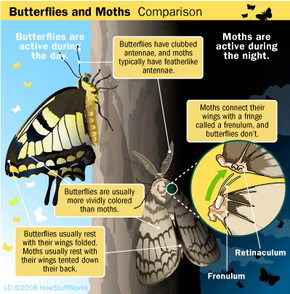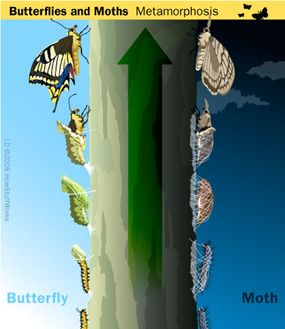Quck answer
Moths and butterflies are both members of the order Lepidoptera, but there are some key differences between the two. Moths tend to have thicker bodies, duller colors, and are active at night. Butterflies, on the other hand, have slender bodies, bright colors, and are active during the day. Moths also tend to have feathery or hairy antennae, while butterflies have thin, straight antennae with a small knob at the end. Finally, moths typically rest with their wings flat against their bodies, while butterflies hold their wings upright and flat when at rest.
Wild Animals

Is the winged creature on your arm a butterfly or a moth?
В©iStockphoto/Valeriy Kirsanov
Imagine a lovely insect lands on your arm one evening while you’re relaxing outside. You can see six legs and two antennae coming out of its narrow body, and it has four broad, sweeping, green wings with delicate red and yellow details. When you gently touch a wing, a bit of powder comes off on your finger. It’s evident to you that this insect is either a butterfly or a moth, but which one is it?
Butterflies and moths share many similarities. They both belong to the scientific order Lepidoptera, which means scale-winged. The name comes from those powdery scales that come off when touched. But they have more in common than just their dusty wings. Both insects start their lives as ravenous caterpillars before completing their transformation into their flying adult forms. They both feed on nectar from flowers and supplement their diet with other liquids, such as mineral-filled standing water and the juice from rotting fruit.
The difference between butterflies and moths is similar to that between frogs and toads. There are some guidelines you can follow to tell them apart, but there are also exceptions. We’ll examine precisely what distinguishes a butterfly from a moth and what clubs and feathers have to do with it.
A Sense of Scale
Although it’s easy to think of moths as small, flitting insects that circle light bulbs, not all moths are tiny. The world’s largest moth is the Atlas moth (Attacus atlas), with a wingspan of about a foot (30.5 centimeters). The largest butterfly, Queen Alexandra’s birdwing (Ornithoptera alexandrae), is about the same size.
The Distinctions Between Moths and Butterflies

The primary differences between butterflies and moths have to do with their appearance and behavior.
2008 HowStuffWorks
The differences between moths and butterflies can be categorized into two groups: behavior and anatomy. Moths are generally nocturnal, flying and feeding at night. Butterflies, on the other hand, are diurnal, active during the day. Therefore, the winged insect you see feeding on a flower in the middle of a spring afternoon is most likely a butterfly. If you watch a large-winged, flitting insect make its way toward a candle at night, it’s probably a moth.
Butterflies and moths also tend to hold their wings differently when they rest. You’ll often see moths with their wings draped down their backs or spread out to the side. Unless butterflies are warming themselves in the sun, they typically hold their wings upright and folded together, perpendicular to their backs.
Butterflies and moths also pupate differently. Both go through their metamorphosis in a chrysalis, or protective shell. However, moths often spin a silk cocoon around their chrysalis, sometimes camouflaging it with leaves or debris.

Most butterflies pupate as a naked chrysalis. Many moths spin silken cocoons to pupate.
2008 HowStuffWorks
The physical differences between moths and butterflies are usually apparent:
The differences between butterflies and moths are easily distinguishable. Butterflies have wider antennae that end with little clubs, while moths’ antennae are often feathery. Butterflies’ wings typically display more vivid colors than moths, although some moths, like the Actias artemis, can be just as colorful. Moths have a series of loops called a retinaculum and a fringe called a frenulum to connect their front and rear wings, which butterflies lack. Moths’ bodies are usually plumper and fuzzier than butterflies’. However, not all Lepidoptera fit into these categories neatly. Skippers, for example, have stocky bodies like moths, but they usually have the clubbed antennae of butterflies. They fly during the day like butterflies but have duller coloring like moths. Skippers hold their wings at a unique angle, with the forewings separate from the hindwings. To learn more about butterflies, moths, and other animals, browse the links on the next page.
FAQ
1. What are moths and butterflies?
Moths and butterflies belong to the same order of insects called Lepidoptera. They are known for their large, colorful wings and their ability to fly. They are found all over the world, in a variety of habitats.
2. What is the main difference between moths and butterflies?
The main difference between moths and butterflies is their antennae. Butterflies have thin, straight antennae with a small ball on the end, while moths have feathery or comb-like antennae. Moths also tend to be more nocturnal and are often attracted to light, while butterflies are more diurnal and active during the day.
3. Are there any physical differences between moths and butterflies?
Aside from their antennae, moths and butterflies also differ in their body shape. Butterflies usually have a slender, more streamlined body, while moths have a stockier, hairier body. Butterflies also tend to have larger wings and brighter colors than moths.
4. How do moths and butterflies develop?
Moths and butterflies go through a complete metamorphosis, meaning they have four distinct stages of development: egg, larva, pupa, and adult. The larva stage is when they are commonly known as caterpillars, and they feed on leaves and other plant materials. The pupa stage is when they undergo a transformation inside a cocoon or chrysalis, and the adult stage is when they emerge as a winged insect.
5. What do moths and butterflies eat?
Moths and butterflies both typically feed on nectar from flowers. However, during their larval stage, they may also feed on leaves, stems, or other plant materials. Some species of moths are known to feed on animal matter, such as wool or fur.
6. How do moths and butterflies defend themselves?
Moths and butterflies have a variety of ways to defend themselves from predators. Some species have brightly colored wings or patterns that warn predators they are toxic or unpalatable. Others have developed camouflage to blend in with their surroundings. Some species of moths have the ability to emit a foul-smelling odor to deter predators.
7. Are moths and butterflies important to the environment?
Moths and butterflies are important pollinators, helping to transfer pollen between plants and ensuring their survival. They also serve as a food source for other animals, including birds, bats, and small mammals.
8. Are moths and butterflies endangered?
Many species of moths and butterflies are facing threats to their survival due to habitat loss, climate change, and pesticide use. Some species have already become endangered or extinct.
9. Can moths and butterflies be kept as pets?
While it is possible to keep moths and butterflies as pets, it is not recommended. Many species have specific dietary and environmental needs that are difficult to replicate in captivity. Additionally, capturing wild insects can have negative impacts on their populations.
10. How long do moths and butterflies live?
The lifespan of moths and butterflies varies by species. Some may live only a few days or weeks, while others may live several months. The adult stage is typically the shortest part of their life cycle.
11. Can moths and butterflies be harmful to humans?
Most species of moths and butterflies are harmless to humans. However, some species may cause damage to crops or other plants. A few species are known to be harmful to humans, such as the oak processionary moth, which can cause skin rashes and respiratory problems.





Leave a Reply